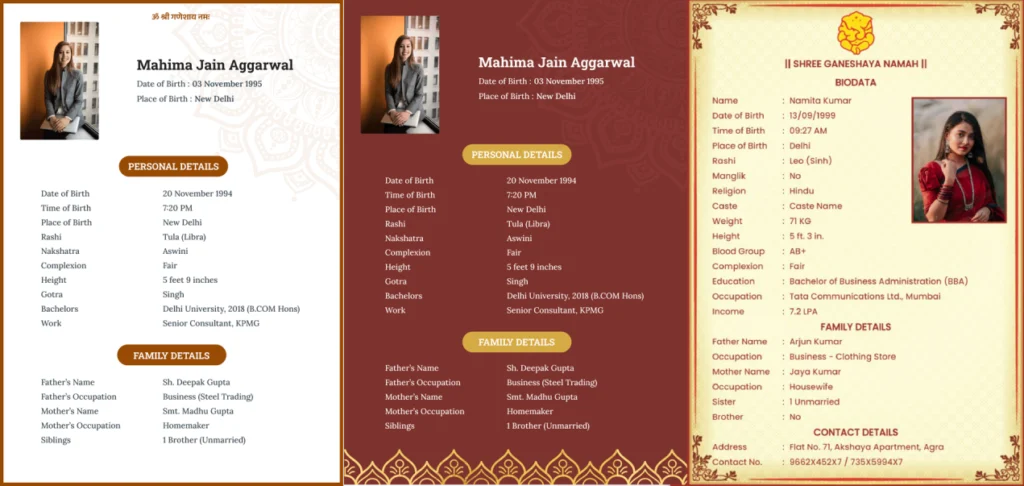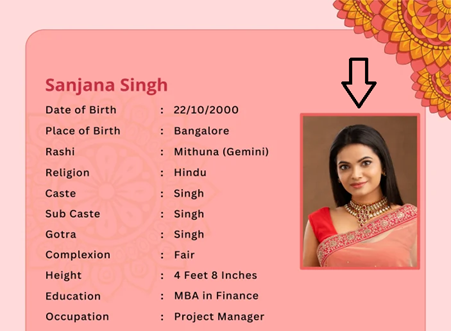In arranged marriages or matrimonial matchmaking, a marriage biodata acts as your formal introduction to a prospective partner and their family. It’s more than just a document — it represents your personal story, family background, lifestyle, and values. A well-crafted biodata can make a strong first impression and increase your chances of finding a compatible match.
This guide will walk you through step-by-step instructions to create the perfect marriage biodata, with tips on format, content, and presentation.
Step 1: Understand What a Marriage Biodata Is
A marriage biodata is similar to a resume, but instead of focusing solely on professional achievements, it highlights personal, cultural, and family-related details. It typically includes:
Personal Details
Name, Age, Date of Birth, Place of Birth, Rashi
Family Background
Parents, Siblings, Family Type, Values
Educational & Professional
Academic Qualifications, Career & Occupation
Think of it as a concise profile that communicates your personality, background, and expectations clearly and professionally.
Step 2: Collect All Essential Information
Before creating your biodata, gather the following details:
Collecting this information ensures accuracy and reduces the chance of leaving out important details.
Step 3: Choose the Right Format

Selecting a clean and professional format is essential for a marriage biodata. The layout should be easy to read, visually appealing, and organized into clear sections.
| Format Type | Description | Ideal For |
|---|---|---|
| Simple Text Format | Minimal design with headings and bullet points | Traditional families, professional approach |
| Photo-Integrated Format | Includes a clear photograph alongside details | Modern approach, visual appeal |
| Decorative Templates | Colourful layouts with borders or design elements | Creative or customized biodatas |
Most online marriage biodata makers offer free templates that are customizable, letting you create a professional biodata in minutes.
Step 4: Write Clear and Accurate Personal Details
Your personal section is the foundation of your biodata. Include:
- Full Name
- Date of Birth & Age
- Religion & Caste (if culturally relevant)
- Languages Spoken
- Gotra, Rashi, or Nakshatra
- Nationality
Step 5: Add Family and Cultural Information
Family details are important in traditional matchmaking, as families often assess cultural compatibility. Include:
- Parents’ names and occupations
- Siblings with basic details
- Family type (nuclear/joint)
- Hometown
This section should provide a snapshot of your upbringing and family values without overwhelming the reader with too much information.
Step 6:Include Educational and Professional Background
This section reflects stability and ambition. Include:
- Degrees and educational institutions
- Certifications or professional achievements
- Job title, company name, and work location
- Annual income (optional, based on comfort)
- Career aspirations or professional goals
Tip: Use bullet points for clarity and keep the information concise yet informative.
Step 7:Lifestyle and Interests
Lifestyle preferences can help assess day-to-day compatibility. Include:
- Hobbies and interests (reading, trekking, music, fitness)
- Travel or leisure preferences
- Fitness or spiritual practices
Sharing this information adds personality and helps families understand your lifestyle.
Step 8:Add a Professional Photograph

A photograph is an essential part of a modern marriage biodata. Tips:
- Use a recent, high-quality photo
- Choose formal or semi-formal attire
- Ensure the background is clean and uncluttered
- Avoid selfies, group photos, or heavy filters
A good photo creates trust and visual appeal.
Step 9:Proofread and Review
Before sharing, carefully review your biodata:
- Correct grammar, spelling, and formatting
- Check for accurate dates and details
- Ensure the layout is clean and readable
- Keep each section focused and concise
A polished biodata shows seriousness and professionalism.
- Use online biodata makers to save time and maintain professional design.
- Highlight unique qualities to stand out.
- Maintain honesty to ensure trust and compatibility.
- Have both digital and printed copies ready for sharing across platforms.
Conclusion
Creating a perfect marriage biodata is about combining clarity, honesty, and personality. By following this step-by-step guide, you can craft a well-structured, professional, and visually appealing biodata that represents you accurately.
Whether you’re sharing it via family networks, matrimonial websites, or online tools, a thoughtfully prepared marriage biodata increases your chances of finding a compatible life partner.
Start today by organizing your details, choosing a clean template, and building a biodata that makes a lasting first impression.
